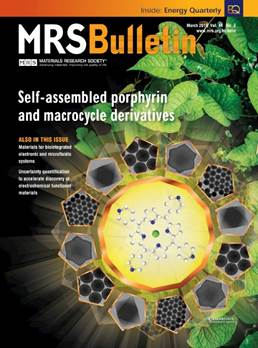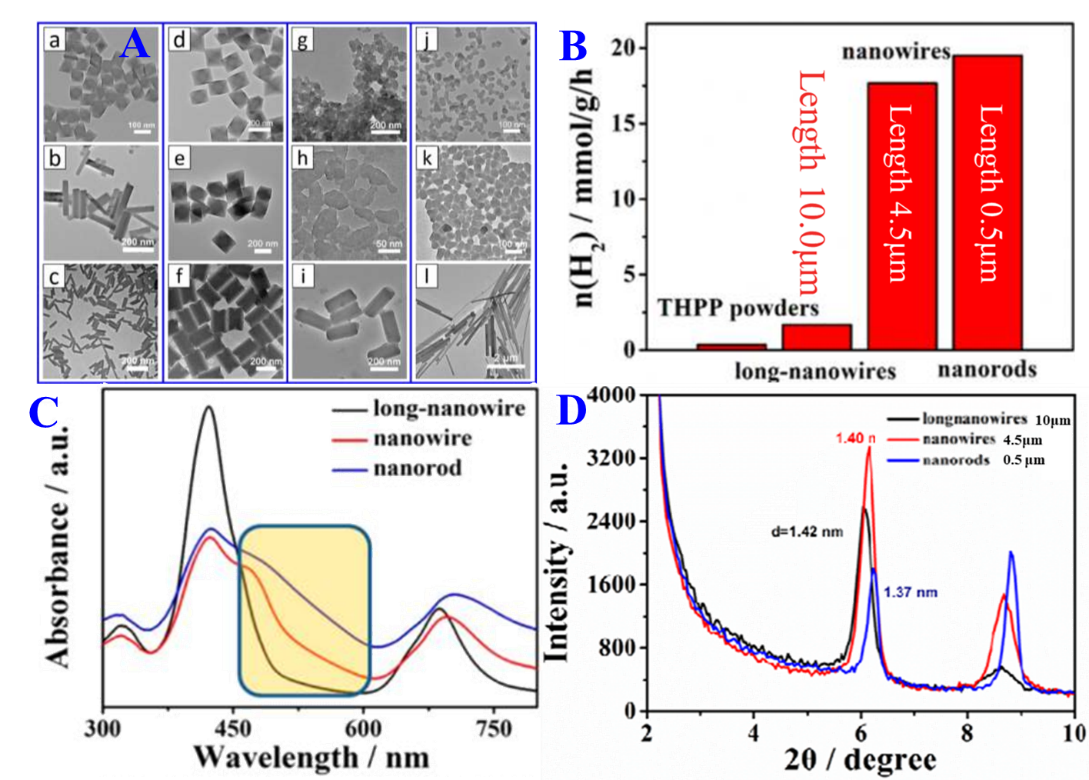Macrocycle molecules (e.g., chlorophyll, heme, etc.) with well-defined size and chemistry are essential molecular building blocks in many biological energy transduction processes. These building blocks are assembled and used by plants, algae, and bacteria for such transduction processes as light harvesting, photo catalysis and synthesis, water splitting, etc. Inspired by their utility and function, many synthetic pigments such as porphyrins and their derivatives with macrocyclic aromatic conjugation systems have been demonstrated to self-assemble into hierarchically structured particle materials with excellent organic semiconductor properties for photocatalytic processes. Aiming to emulate natural light harvesting processes and energy storage, there have been widespread efforts in the synthesis, self-assembly, and integration of these photoactive pigment materials in important applications including photodegradation of organic pollutants, photocatalytic water splitting and hydrogen production, photosynthesis of fuel cell catalysts, and photodynamic therapy.
In March 2019, the journal of MRS bulletin published a special issue entitled "self-assembled porphyrin and macrocycle derivatives". This issue reviews the latest progress in controllable assembly and application of porphyrins and their derivatives, and discusses the future research trends. Professor Bai Feng's group published three related reviews in this issue.

Figure 1, frontpage of the "self-assembled porphyrin and macrocycle derivatives" special issue of MRS bulletin
[review 1] Size-and Shap-dependent Photocatalysis of Porphyrin Nanocrystals
A summary paper was published in MRS Bulletin by professor Feng Bai, from the Key Laboratory for Special Functional Materials of the Ministry of Education. It is systematically discussed that porphyrin nanocrystals of various morphologies and sizes can be formed by the interaction of weak bonds such as π-π stacking and ligand coordination.
These porphyrin nanocrystals with regular morphology and uniform structure can not only inherit the light harvesting, photocatalytic synthesis, water splitting, and photodegradation characteristics of the porphyrins themselves, but more importantly, these porphyrin nanocrystals show the interesting size- and shape-dependent photocatalytic activity. On this basis, the research progress of important photocatalytic processes such as photodegradation of organic pollutants, photocatalytic water splitting and hydrogen production, and photosynthesis of metallic fuel-cell catalysts are highlighted, and the dependence of these photocatalytic processes on size and shape is discussed. (Li Q., Zhao N., Bai F. (2019). Size- and shape-dependent photocatalysis of porphyrin nanocrystals. MRS Bulletin, 44(3), 172-177.)

Figure 2, Porphyrin nanocrystals with different morphologies and sizes
[review 2] Cooperative self-assembly of porphyrins and derivatives
In recent years, the research on making porphyrins and their derivatives into ordered structures for simulating photosynthesis and energy storage has attracted extensive attention in the field of self-assembly. Developing reliable synthesis methods is the key to utilize the structural and functional advantages of porphyrins. Professor Wei Wenbo and Dr. Sun Jiajie, and Professor Hongyou fan (Sandia National Laboratory of the United States) jointly published the “Cooperative self-assembly of porphyrins and derivatives”. This review paper provides a comprehensive prospect for the molecular chemistry of porphyrins and their derivatives, and discusses the preparation of functional porphyrins by surfactant assisted self-assembly using amphiphilic molecules. In this method, the nucleation and growth of porphyrin molecules are confined in the formation of "micelle like" structures of surfactant molecules. Driven by intermolecular interactions such as π - π stacking and axial coordination, porphyrin molecules are assembled into 1d-3d ordered nanostructures with optical and electrical activities. The scale and assembly dynamics can be controlled by adjusting the structure. This kind of ordered nanostructures with controllable size, morphology and molecular arrangement will help to deepen the understanding of "synthesis structure characteristics", and enhance the application of molecular porphyrins in light utilization and energy storage. (Wenbo Wei , * Jiajie Sun , * and Hongyou Fan(2019). Cooperative self-assembly of porphyrins and derivatives. MRS Bulletin, 44(3), 178-182. doi:10.1557/mrs.2019.39)

Figure3, images of porphyrin nanomaterials with different shapes and sizes synthesized through the surfactant-assisted cooperative self-assembly method.
[Review 3] Electrical and light-trapping properties of the self-assembled structure of two-element porphyrin
Dr. Zhong Yong from the Key Laboratory of Special Functional Materials of the Ministry of Education of Henan University, Dr. Wang Jiefei from the School of Life Sciences, Henan University, and Senior Researcher Tian Yongmin from Angstrom Thin Film Technology Co., Ltd. of United States jointly published the review paper title "Binary ionic porphyrin self-assembly: Structures, and electronic and light-harvesting properties". Porphyrins are an important class of organic conjugated molecules, similarly in structure and function to natural photosynthetic chlorophyll molecules and enzymatic chromophores. However, most porphyrins are difficult to dissolve in water, making the morphology and the yield of porphyrin nanomaterials are difficult to control. The diversity of peripheral functional groups and central metals of porphyrins result in the diversity of ionic porphyrin forms. The self-assembled crystalline solids of anionic and cationic porphyrins provide a new class of multifunctional photoelectric micro/nano materials, which can effectively solve this problem. This review systematically summarizes the process of binary ion porphyrin self-assembly (ISA), the ion form of porphyrin, the hierarchical structure formed by ionic porphyrin self-assembly, and the spectral characteristics, exciton delocalization and expanded π-π stacking structure. These structural characteristics endow them excellent light trapping performance, electronic and energy transfer function performance, which is widely used in sensors, photovoltaic devices, photocatalysts and solar cells. The authors introduced in detail the influencing factors and control methods of the ion self-assembly process, and these assemblies applied in photocatalytic hydrogen production, photocatalytic reduction of metal ions, and photocatalytic reduction of CO2. The article not only summarizes and introduces the multi-level structure and applications in recent years, but also provides a new platform for the development of new high-performance, stable and durable optoelectronic devices. (Zhong Y., Wang J., Tian Y. (2019). Binary ionic porphyrin self-assembly: Structures, and electronic and light-harvesting properties. MRS Bulletin, 44(3), 183-188. doi:10.1557/mrs.2019.40)

Figure 4: Binary ion self-assembly process and corresponding nanocrystalline morphology